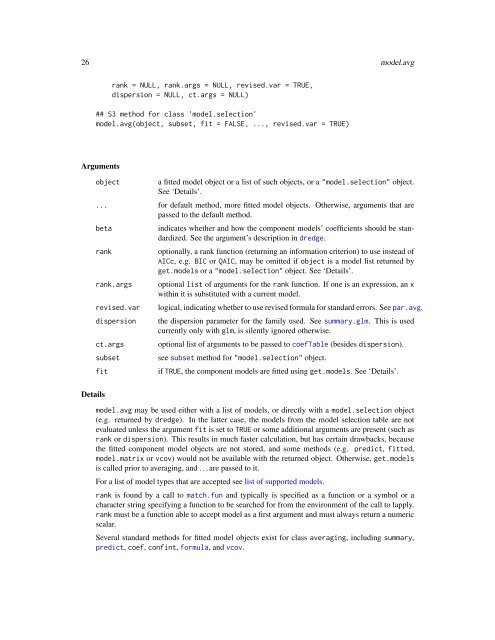Package ‘MuMIn’
Package 'MuMIn'
Package 'MuMIn'
You also want an ePaper? Increase the reach of your titles
YUMPU automatically turns print PDFs into web optimized ePapers that Google loves.
26 model.avg<br />
rank = NULL, rank.args = NULL, revised.var = TRUE,<br />
dispersion = NULL, ct.args = NULL)<br />
## S3 method for class model.selection<br />
model.avg(object, subset, fit = FALSE, ..., revised.var = TRUE)<br />
Arguments<br />
object<br />
a fitted model object or a list of such objects, or a "model.selection" object.<br />
See ‘Details’.<br />
... for default method, more fitted model objects. Otherwise, arguments that are<br />
passed to the default method.<br />
beta<br />
rank<br />
rank.args<br />
revised.var<br />
dispersion<br />
ct.args<br />
subset<br />
fit<br />
indicates whether and how the component models’ coefficients should be standardized.<br />
See the argument’s description in dredge.<br />
optionally, a rank function (returning an information criterion) to use instead of<br />
AICc, e.g. BIC or QAIC, may be omitted if object is a model list returned by<br />
get.models or a "model.selection" object. See ‘Details’.<br />
optional list of arguments for the rank function. If one is an expression, an x<br />
within it is substituted with a current model.<br />
logical, indicating whether to use revised formula for standard errors. See par.avg.<br />
the dispersion parameter for the family used. See summary.glm. This is used<br />
currently only with glm, is silently ignored otherwise.<br />
optional list of arguments to be passed to coefTable (besides dispersion).<br />
see subset method for "model.selection" object.<br />
if TRUE, the component models are fitted using get.models. See ‘Details’.<br />
Details<br />
model.avg may be used either with a list of models, or directly with a model.selection object<br />
(e.g. returned by dredge). In the latter case, the models from the model selection table are not<br />
evaluated unless the argument fit is set to TRUE or some additional arguments are present (such as<br />
rank or dispersion). This results in much faster calculation, but has certain drawbacks, because<br />
the fitted component model objects are not stored, and some methods (e.g. predict, fitted,<br />
model.matrix or vcov) would not be available with the returned object. Otherwise, get.models<br />
is called prior to averaging, and . . . are passed to it.<br />
For a list of model types that are accepted see list of supported models.<br />
rank is found by a call to match.fun and typically is specified as a function or a symbol or a<br />
character string specifying a function to be searched for from the environment of the call to lapply.<br />
rank must be a function able to accept model as a first argument and must always return a numeric<br />
scalar.<br />
Several standard methods for fitted model objects exist for class averaging, including summary,<br />
predict, coef, confint, formula, and vcov.


